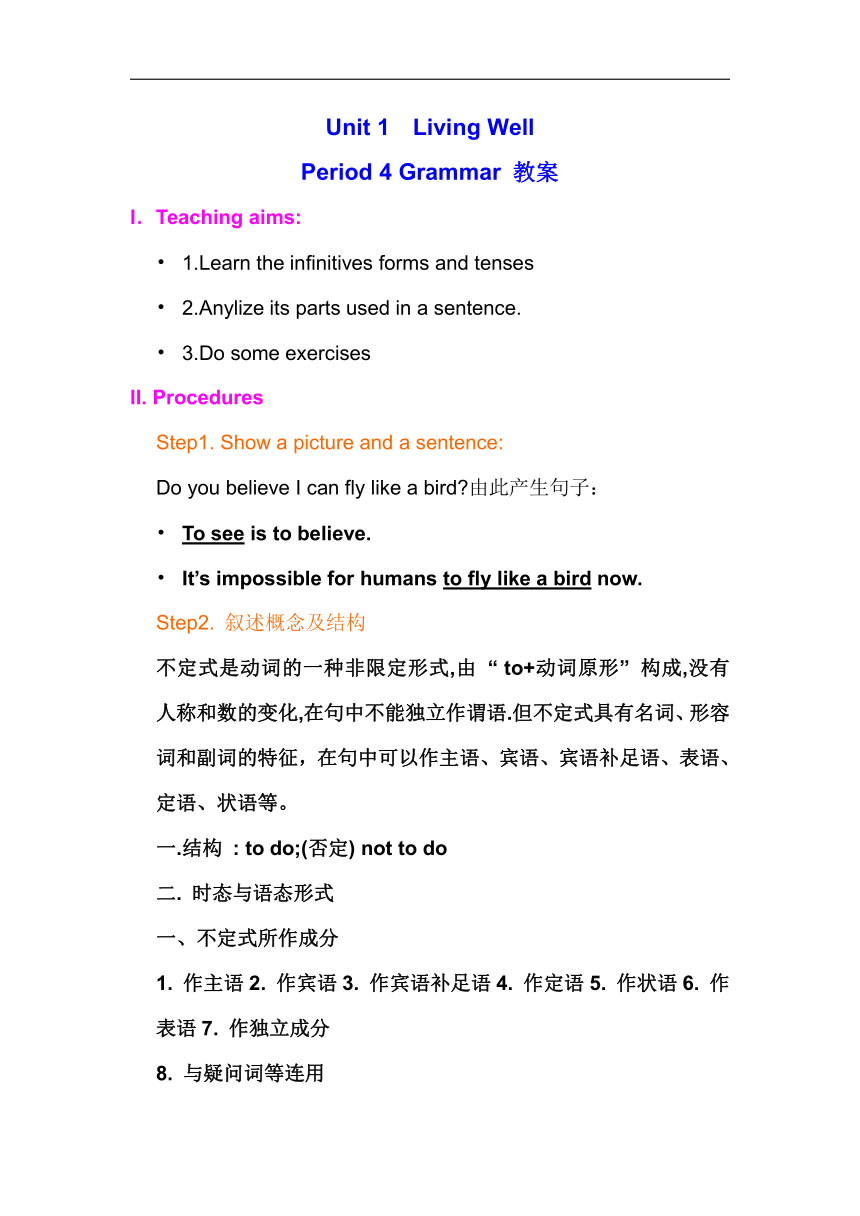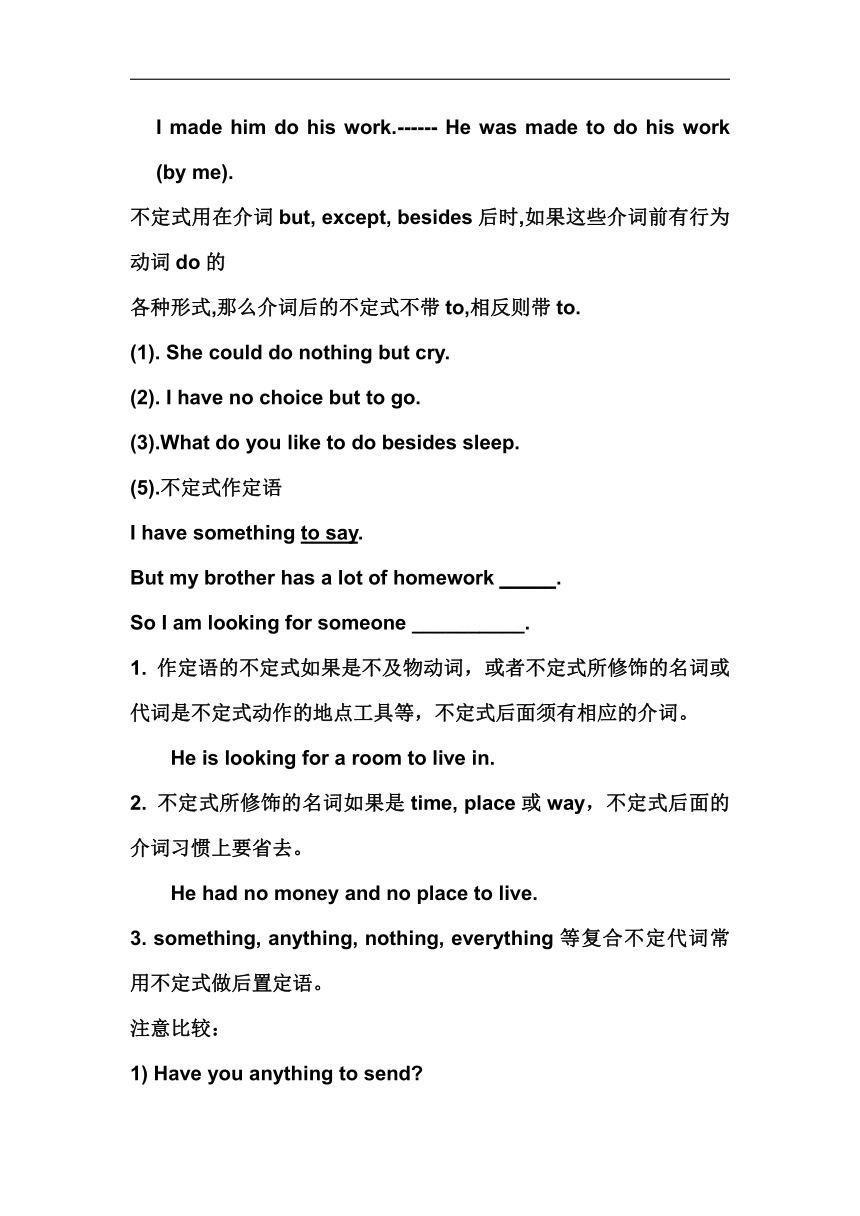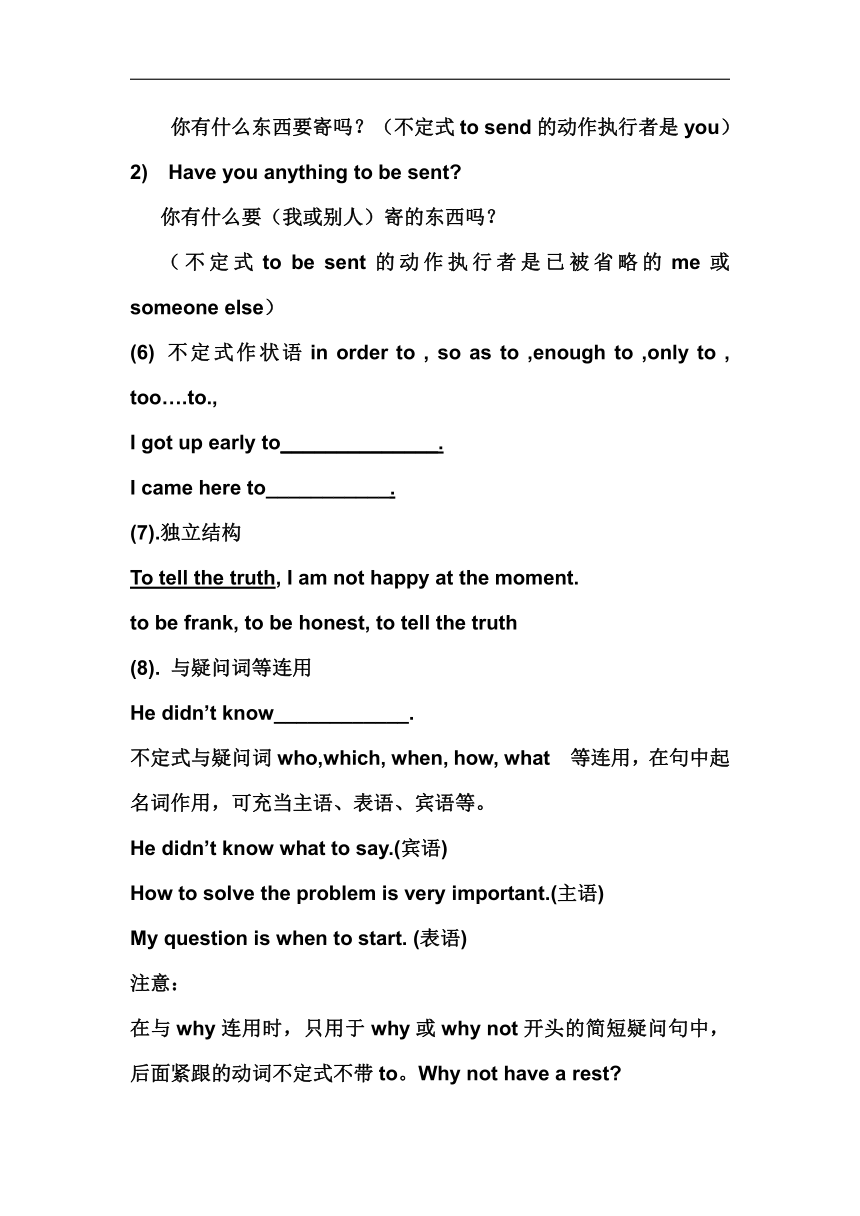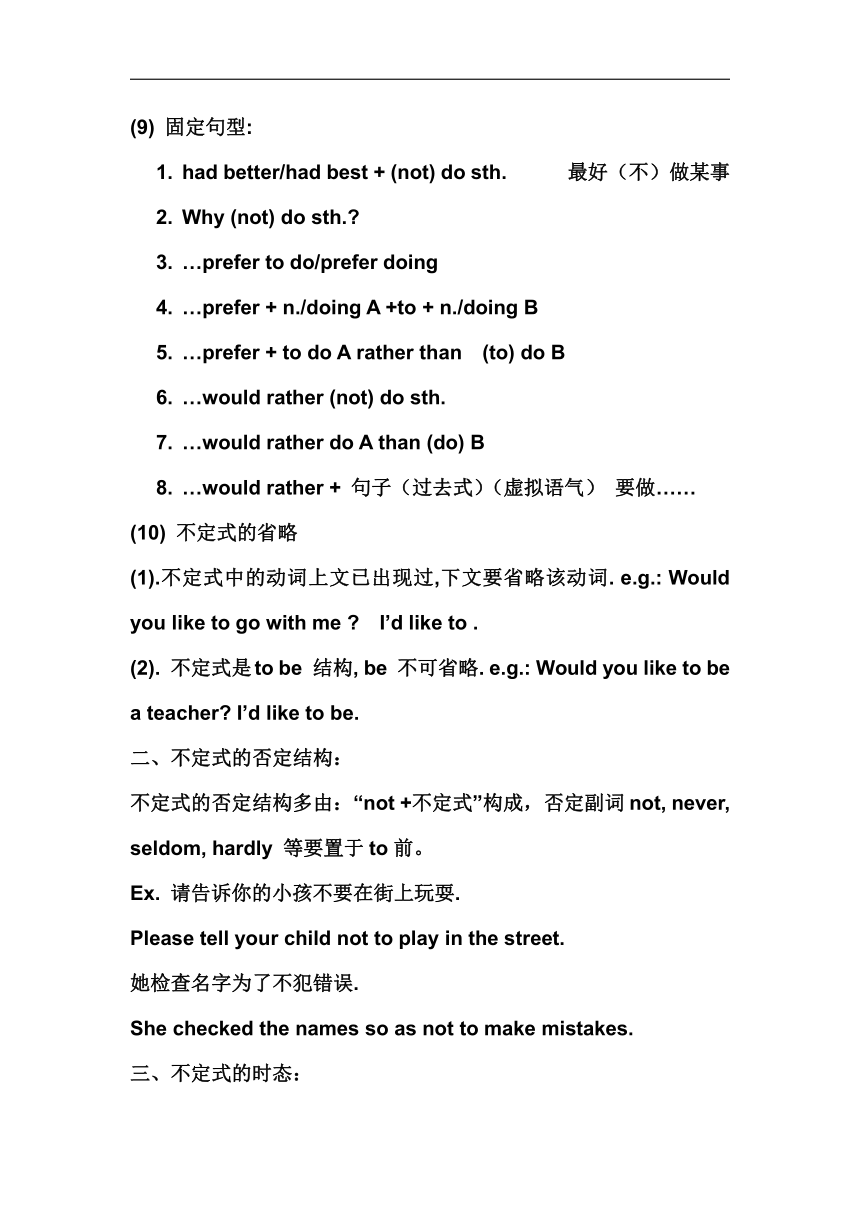人教新课标高二英语选修七 Unit1 Living well grammar教案
文档属性
| 名称 | 人教新课标高二英语选修七 Unit1 Living well grammar教案 |  | |
| 格式 | zip | ||
| 文件大小 | 16.7KB | ||
| 资源类型 | 教案 | ||
| 版本资源 | 人教版(新课程标准) | ||
| 科目 | 英语 | ||
| 更新时间 | 2019-10-16 11:11:14 | ||
图片预览





文档简介
Unit 1 Living Well
Period 4 Grammar 教案
I.Teaching aims:
1.Learn the infinitives forms and tenses
2.Anylize its parts used in a sentence.
3.Do some exercises
II. Procedures
Step1. Show a picture and a sentence:
Do you believe I can fly like a bird?由此产生句子:
To see is to believe.
It’s impossible for humans to fly like a bird now.
Step2. 叙述概念及结构
不定式是动词的一种非限定形式,由 “ to+动词原形” 构成,没有人称和数的变化,在句中不能独立作谓语.但不定式具有名词、形容词和副词的特征,在句中可以作主语、宾语、宾语补足语、表语、定语、状语等。
结构 : to do;(否定) not to do
二. 时态与语态形式
一、不定式所作成分
1. 作主语2. 作宾语3. 作宾语补足语4. 作定语5. 作状语6. 作表语7. 作独立成分
8. 与疑问词等连用
分述:
(1).不定式作主语时,往往放在谓语之后,用it作形式主语.
To see is to believe.
It’s impossible for humans to fly like a bird now.
(2).不定式作表语
My job is to protect the world.
Your task is to_____________ .
(3) 不定式作宾语
He likes to______________.
I found it still necessary
to ___________ if he want to win.
think/ consider/ find it + adj.+ to do
常用动词不定式作宾语的动词有:hope, refuse, learn, set out choose, decide, agree, manage, pretend, plan.
(4). 不定式作宾补
The teacher told me to_________. I expect you to____________.
warn, tell, allow, help, ask, force等
五看watch;see;look at; observe;notice;
一感: feel
三使: let; make; have
二听: listen to ; hear
I made him do his work.------ He was made to do his work (by me).
不定式用在介词but, except, besides后时,如果这些介词前有行为动词do的
各种形式,那么介词后的不定式不带to,相反则带to.
(1). She could do nothing but cry.
(2). I have no choice but to go.
(3).What do you like to do besides sleep.
(5).不定式作定语
I have something to say.
But my brother has a lot of homework _____.
So I am looking for someone __________.
1. 作定语的不定式如果是不及物动词,或者不定式所修饰的名词或代词是不定式动作的地点工具等,不定式后面须有相应的介词。
He is looking for a room to live in.
2. 不定式所修饰的名词如果是time, place或way,不定式后面的介词习惯上要省去。
He had no money and no place to live.
3. something, anything, nothing, everything等复合不定代词常用不定式做后置定语。
注意比较:
1) Have you anything to send?
你有什么东西要寄吗?(不定式to send的动作执行者是you)
2) Have you anything to be sent?
你有什么要(我或别人)寄的东西吗?
(不定式to be sent的动作执行者是已被省略的me或someone else)
(6) 不定式作状语in order to , so as to ,enough to ,only to , too….to.,
I got up early to______________. I came here to___________.
(7).独立结构
To tell the truth, I am not happy at the moment.
to be frank, to be honest, to tell the truth
(8). 与疑问词等连用
He didn’t know____________.
不定式与疑问词who,which, when, how, what 等连用,在句中起名词作用,可充当主语、表语、宾语等。
He didn’t know what to say.(宾语)
How to solve the problem is very important.(主语) My question is when to start. (表语)
注意:
在与why连用时,只用于why或why not开头的简短疑问句中,后面紧跟的动词不定式不带to。Why not have a rest?
(9) 固定句型:
had better/had best + (not) do sth. 最好(不)做某事
Why (not) do sth.?
…prefer to do/prefer doing
…prefer + n./doing A +to + n./doing B
…prefer + to do A rather than (to) do B
…would rather (not) do sth.
…would rather do A than (do) B
…would rather + 句子(过去式)(虚拟语气) 要做……
(10) 不定式的省略
(1).不定式中的动词上文已出现过,下文要省略该动词. e.g.: Would you like to go with me ? I’d like to .
(2). 不定式是to be 结构, be 不可省略. e.g.: Would you like to be a teacher? I’d like to be.
二、不定式的否定结构:
不定式的否定结构多由: “not +不定式”构成, 否定副词not, never, seldom, hardly 等要置于to前。
Ex. 请告诉你的小孩不要在街上玩耍.
Please tell your child not to play in the street.
她检查名字为了不犯错误.
She checked the names so as not to make mistakes.
三、不定式的时态:
(1)一般时表示的动作,有时与谓语动词表示的动作同时发生,有时发生在谓语动词表示的动作之后。
Ex. He seems to know this.他似乎知道这事。
I hope to see you again. 我希望再见到你。
(2)完成时表示的动作发生在谓语动词表示的动作之前。
很抱歉给了你这么多麻烦。
Ex. I’m sorry to have given you so much trouble.
(3) 一般进行时表示的动作正在进行,与谓语动词表示的动作同时发生。
Ex.他好象正在吃什么东西。
He seems to be eating something.
(4)完成进行时表示的动作从过去开始并延续至说话的时候。
据说她研究这问题有好多年了。
She is said to have been working on the problem for many years.
Step3. Exercises
1.She reached the top of the hill and stopped______ on a big rock by the side of the path.
to have rested B. resting C. to rest D. rest
2.We’re planning ______ a party next week.
A. to have B. have C. having D. had
3. ---Which do you prefer ____ your weekends, fishing or watching TV?
---- Neither.
Spending B. to spend C. being spent D. spend
4.Did you find out _____ the pie out of the oven?
A. When to take B. to take C. have taken D. being taken
5._____ get a complete picture, further information is needed.
In order that B. In order to
C. Being D. To have
6. It ‘s necessary ____ some English grammar.
A. for students to learn B. for students learning
C. of students to learn D. of students learning
7. I ought to ____ him the news, but I forgot to do so.
A. remember to tell B. remember telling
C. have remembered to tell D. have remembered telling
8. I ____ you the exciting news, but you were not at home.
Meant telling B. meant to telling
C. Meant to having told D. meant to tell
9. Robert is said ____ abroad, but I don’t know what country he studied in.
to have studied B. to study
C. to be studying D. to have been studying
10. The purpose of new technologies is to make life easier, ____ it more difficult.
not make B. not to make
C. not making D. don’t make
11. I’ve worked with children before, so I know what ____ in my new job.
expected B. to expect
C. to be expecting D. expects
12. Having a trip abroad is certainly good for the old couple, but it remains ____ whether they will enjoy it.
to see B. to be seen C. seeing D. see
13. It is said in Australia there is more land than the government knows ____.
it what to do with B. what to do with it
C. what to do it with D. to do what with it
14. The mother didn’t know ____ to blame for the broken glass as it happened while she was out.
A. who B. when C. how D. why
15. Paul doesn’t have to be made ____. He always works hard.
A. learn B. to learn C. learned D. learning
16. We agreed ____ here but so far she hasn’t turned up yet.
A. having met B. meeting C. to meet D. to have met
17. The boy wanted to ride his bicycle in the street, but his mother told him ____.
A. not to B. not to do C. not do it D. do not to
18. The patient was warned ____ oily food after the operation.
A. to eat not B. eating not
C. not to eat D. not eating
19. I would love ____ to the party last night but I had to work extra hours to finish a report.
A. to go B. to have gone
C. going D. having gone
20. Charles Babbage is generally considered ____the first computer.
A. to invent B. inventing
C. to have invented D. having invented
Step4. Homework
1. Revise the rules of infinitive.
2. Finish the exercises of “Discovering useful structures” on Page 5.
Period 4 Grammar 教案
I.Teaching aims:
1.Learn the infinitives forms and tenses
2.Anylize its parts used in a sentence.
3.Do some exercises
II. Procedures
Step1. Show a picture and a sentence:
Do you believe I can fly like a bird?由此产生句子:
To see is to believe.
It’s impossible for humans to fly like a bird now.
Step2. 叙述概念及结构
不定式是动词的一种非限定形式,由 “ to+动词原形” 构成,没有人称和数的变化,在句中不能独立作谓语.但不定式具有名词、形容词和副词的特征,在句中可以作主语、宾语、宾语补足语、表语、定语、状语等。
结构 : to do;(否定) not to do
二. 时态与语态形式
一、不定式所作成分
1. 作主语2. 作宾语3. 作宾语补足语4. 作定语5. 作状语6. 作表语7. 作独立成分
8. 与疑问词等连用
分述:
(1).不定式作主语时,往往放在谓语之后,用it作形式主语.
To see is to believe.
It’s impossible for humans to fly like a bird now.
(2).不定式作表语
My job is to protect the world.
Your task is to_____________ .
(3) 不定式作宾语
He likes to______________.
I found it still necessary
to ___________ if he want to win.
think/ consider/ find it + adj.+ to do
常用动词不定式作宾语的动词有:hope, refuse, learn, set out choose, decide, agree, manage, pretend, plan.
(4). 不定式作宾补
The teacher told me to_________. I expect you to____________.
warn, tell, allow, help, ask, force等
五看watch;see;look at; observe;notice;
一感: feel
三使: let; make; have
二听: listen to ; hear
I made him do his work.------ He was made to do his work (by me).
不定式用在介词but, except, besides后时,如果这些介词前有行为动词do的
各种形式,那么介词后的不定式不带to,相反则带to.
(1). She could do nothing but cry.
(2). I have no choice but to go.
(3).What do you like to do besides sleep.
(5).不定式作定语
I have something to say.
But my brother has a lot of homework _____.
So I am looking for someone __________.
1. 作定语的不定式如果是不及物动词,或者不定式所修饰的名词或代词是不定式动作的地点工具等,不定式后面须有相应的介词。
He is looking for a room to live in.
2. 不定式所修饰的名词如果是time, place或way,不定式后面的介词习惯上要省去。
He had no money and no place to live.
3. something, anything, nothing, everything等复合不定代词常用不定式做后置定语。
注意比较:
1) Have you anything to send?
你有什么东西要寄吗?(不定式to send的动作执行者是you)
2) Have you anything to be sent?
你有什么要(我或别人)寄的东西吗?
(不定式to be sent的动作执行者是已被省略的me或someone else)
(6) 不定式作状语in order to , so as to ,enough to ,only to , too….to.,
I got up early to______________. I came here to___________.
(7).独立结构
To tell the truth, I am not happy at the moment.
to be frank, to be honest, to tell the truth
(8). 与疑问词等连用
He didn’t know____________.
不定式与疑问词who,which, when, how, what 等连用,在句中起名词作用,可充当主语、表语、宾语等。
He didn’t know what to say.(宾语)
How to solve the problem is very important.(主语) My question is when to start. (表语)
注意:
在与why连用时,只用于why或why not开头的简短疑问句中,后面紧跟的动词不定式不带to。Why not have a rest?
(9) 固定句型:
had better/had best + (not) do sth. 最好(不)做某事
Why (not) do sth.?
…prefer to do/prefer doing
…prefer + n./doing A +to + n./doing B
…prefer + to do A rather than (to) do B
…would rather (not) do sth.
…would rather do A than (do) B
…would rather + 句子(过去式)(虚拟语气) 要做……
(10) 不定式的省略
(1).不定式中的动词上文已出现过,下文要省略该动词. e.g.: Would you like to go with me ? I’d like to .
(2). 不定式是to be 结构, be 不可省略. e.g.: Would you like to be a teacher? I’d like to be.
二、不定式的否定结构:
不定式的否定结构多由: “not +不定式”构成, 否定副词not, never, seldom, hardly 等要置于to前。
Ex. 请告诉你的小孩不要在街上玩耍.
Please tell your child not to play in the street.
她检查名字为了不犯错误.
She checked the names so as not to make mistakes.
三、不定式的时态:
(1)一般时表示的动作,有时与谓语动词表示的动作同时发生,有时发生在谓语动词表示的动作之后。
Ex. He seems to know this.他似乎知道这事。
I hope to see you again. 我希望再见到你。
(2)完成时表示的动作发生在谓语动词表示的动作之前。
很抱歉给了你这么多麻烦。
Ex. I’m sorry to have given you so much trouble.
(3) 一般进行时表示的动作正在进行,与谓语动词表示的动作同时发生。
Ex.他好象正在吃什么东西。
He seems to be eating something.
(4)完成进行时表示的动作从过去开始并延续至说话的时候。
据说她研究这问题有好多年了。
She is said to have been working on the problem for many years.
Step3. Exercises
1.She reached the top of the hill and stopped______ on a big rock by the side of the path.
to have rested B. resting C. to rest D. rest
2.We’re planning ______ a party next week.
A. to have B. have C. having D. had
3. ---Which do you prefer ____ your weekends, fishing or watching TV?
---- Neither.
Spending B. to spend C. being spent D. spend
4.Did you find out _____ the pie out of the oven?
A. When to take B. to take C. have taken D. being taken
5._____ get a complete picture, further information is needed.
In order that B. In order to
C. Being D. To have
6. It ‘s necessary ____ some English grammar.
A. for students to learn B. for students learning
C. of students to learn D. of students learning
7. I ought to ____ him the news, but I forgot to do so.
A. remember to tell B. remember telling
C. have remembered to tell D. have remembered telling
8. I ____ you the exciting news, but you were not at home.
Meant telling B. meant to telling
C. Meant to having told D. meant to tell
9. Robert is said ____ abroad, but I don’t know what country he studied in.
to have studied B. to study
C. to be studying D. to have been studying
10. The purpose of new technologies is to make life easier, ____ it more difficult.
not make B. not to make
C. not making D. don’t make
11. I’ve worked with children before, so I know what ____ in my new job.
expected B. to expect
C. to be expecting D. expects
12. Having a trip abroad is certainly good for the old couple, but it remains ____ whether they will enjoy it.
to see B. to be seen C. seeing D. see
13. It is said in Australia there is more land than the government knows ____.
it what to do with B. what to do with it
C. what to do it with D. to do what with it
14. The mother didn’t know ____ to blame for the broken glass as it happened while she was out.
A. who B. when C. how D. why
15. Paul doesn’t have to be made ____. He always works hard.
A. learn B. to learn C. learned D. learning
16. We agreed ____ here but so far she hasn’t turned up yet.
A. having met B. meeting C. to meet D. to have met
17. The boy wanted to ride his bicycle in the street, but his mother told him ____.
A. not to B. not to do C. not do it D. do not to
18. The patient was warned ____ oily food after the operation.
A. to eat not B. eating not
C. not to eat D. not eating
19. I would love ____ to the party last night but I had to work extra hours to finish a report.
A. to go B. to have gone
C. going D. having gone
20. Charles Babbage is generally considered ____the first computer.
A. to invent B. inventing
C. to have invented D. having invented
Step4. Homework
1. Revise the rules of infinitive.
2. Finish the exercises of “Discovering useful structures” on Page 5.
